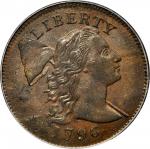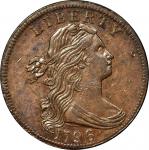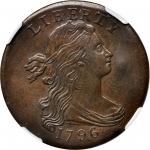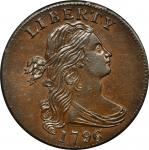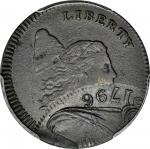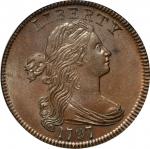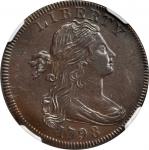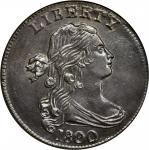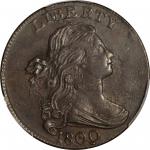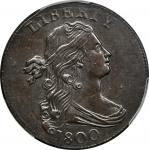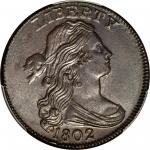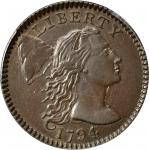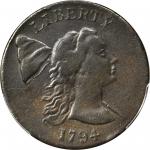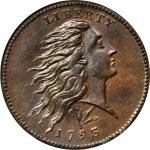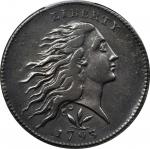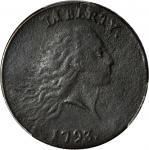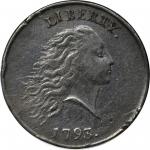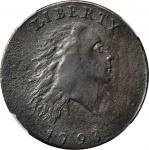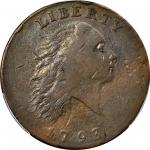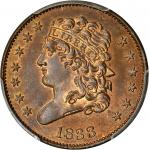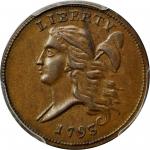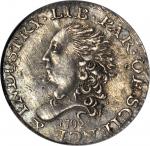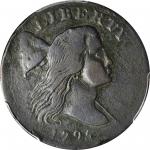1795 Liberty Cap Cent. S-80. Rarity-5+. Jefferson Head. Plain Edge. Fine-15 (PCGS).An inviting example of this enigmatic rarity from the early large cent series. Deep copper-rose patina blankets both sides, the detail of which is bold for the grade apart from minor softness along the upper and lower right reverse border. The surfaces are uniformly microporous with light olive-russet encrustation that is largely confined to the protected areas around the devices. There are few sizeable marks, however, a few shallow scuffs at the digit 1 in the date and a tiny void on the liberty cap being the most useful identifying features.<p>This variety was coined outside the United States Mint by John Harper in an attempt to win a private coining contract. Harpers name is well known to numismatists, as his humble saw shop (sometimes mistakenly called a "cellar") is thought to have been the facility where the first 1792 half dismes were struck, standing in for the still-unfinished United States Mint building nearby. Harpers shop, where this coin was struck, was on the northeast corner of North 6th and Cherry streets, a stones throw from President Washingtons house at 5th and Market and within sight of Independence Hall; the site is now occupied by the National Constitution Center. The First Philadelphia Mint was a little over a block away on 7th Street. Harpers proximity and skill set made him a natural partner for the Mint, and he turns up several times in the Mints account books: providing a press and mechanical assistance in 1792, selling saws in 1793, and selling a pair of rollers in 1794. Harpers talents as a blacksmith and machinist were well known to the Mint when Elias Boudinot, then a congressman, sought advice from Mint assayer Albion Cox on how to improve the Mints processes and production. Cox took "the liberty of recommending to you a practical man who operated in the New Jersey coppers -- he will give you such information with respect to the proceedings of coinage as will appear almost incredible when contrasted with the present proceedings." Assuming that Boudinot, then in the midst of an inquisition into the Mints operations on behalf of Congress, must "be acquainted with the defects" of that institution, Cox strongly recommended he talk to "John Harper, now very extensively in the saw-making business near the iron works at Trenton." According to Pete Smith, Joel J. Orosz, and Leonard Augsburger in the book <em>1792: Birth of a Nations Coinage</em>, Harper "visited the Mint on January 23, 1795, and suggested improvements but [Director David] Rittenhouse and the staff of the Mint were not impressed." Rittenhouse resigned the following June, followed in the directors office by Henry deSaussure, who lasted until just October. The next Mint director was Elias Boudinot, who had been hearing about Harper for nearly a year by that point.<p>Harper reached out to Boudinot almost immediately after his appointment. He wrote on November 4, 1795:"I propose to engage with you....to receive sheet copper of the right size and coin the same into cents complete for circulation at the rate of eighty dollars per ton and to return the same in Cents and shruf deducting twenty-five pounds in each ton for waste. I will also forge and harden all the dies, beds, and punches for the same." Recognizing that promises and actions are two different things, Harper showed Boudinot what he could do. He made dies and struck the coins that we today call Jefferson Head cents. Elias Boudinot dutifully reported to Congress on Harpers work on February 3, 1796. He told the House of Representatives that Harper had "with great candor and freedom communicated his knowledge" but, having felt a cold reception by the current staff at the Mint during his interaction with them, decided to "make a press and cutting machine at his own expense." A few weeks later, according to Smith et al.:<p><em>"Without Congressional authority, Harper produced dies, built a press, and invited the committee [of the House of Representatives] to observe his ability to produce cents faster and more efficiently than the Mint. The committee was impressed and dug into their own pockets to reimburse Harper for the copper used. Perhaps they took home a few of his cents as mementos."</em><p>It made Boudinot nervous that Harper had dies that looked so much like federal cents, so he informed Congress that when he "found the dies used by the memorialist [Harper] still in his possession and conceiving this to be very improper [he] took them into the Mint." When he realized that he had no power to reimburse Harper for the dies or his other labors, Boudinot offered him a job as assistant coiner. Harper declined.<p>Within 70 years, Harpers cents were valuable collectibles. The earliest acknowledgement of the desirability of the "Jefferson Head" cents appears in W. Elliot Woodwards sale of October 1864, where lot 617 was described as "1795 Sometimes called the Jefferson Head, in rather poor condition but an extremely rare type." William Strobridge, a coin dealer then based in New York, bought it for one dollar. It is unknown when this variety was first identified as distinctive, or given the name "Jefferson Head," or by whom. The earliest reference of which we are aware is Edward Cogans sale of June 1864, where one was listed under the heading of "Fabrications," along with things like Bolen copies and pieces with altered dates. Described as "1795 Cent, Jefferson Head," it sold for a quarter. If Cogan could simply call it a "Jefferson Head" and assume bidders would know what it was, and Woodward could use the same name just a few months later, the moniker must have had general currency among numismatists by then.<p>By the 20th century, the Jefferson Head cent was revered as a distinctive rarity in the early copper series. Initially dismissed as a counterfeit intended for circulation, Walter Breen appears to have been the first to make the connection between these cents and John Harpers experiment, leading modern collectors to appreciate these coins as not only rarities, but historical relics of the Mints unsteady infancy. Nearly all surviving specimens are heavily circulated, and many are impaired. Three varieties are known: Sheldon-80, as here, with a plain edge; 1795 NC-1, with a different reverse die and a lettered edge; and 1795 NC-4, from the same dies as Sheldon-80 but with a lettered edge. Among the three varieties, not a single example exceeds Very Fine and, indeed, survivors are highly prized regardless of level of preservation. The present example would certainly serve as a centerpiece in an advanced numismatic cabinet. From the Collection of Thaddeus A. Tatum III.



